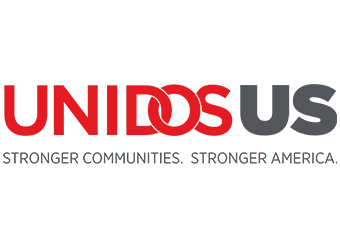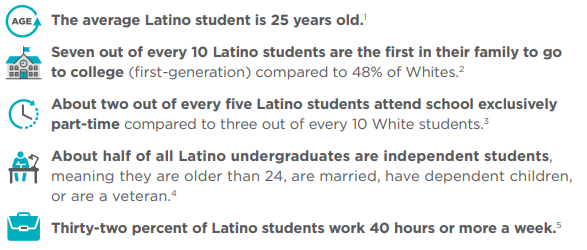 September 15-October 15 marks National Hispanic Heritage Month, when we celebrate the contributions of Americans with roots from Spain, Mexico, Central America, South American and the Spanish-speaking nations of the Caribbean. The month also offers a time to look at the findings from a recent UNIDOS US report, Following Their Dreams in an Inequitable System: Latino Students Share Their College Experience. The study, which relies heavily on quotes from students in Florida, spotlights the experience of Latino students in college, and highlights areas of concern.
September 15-October 15 marks National Hispanic Heritage Month, when we celebrate the contributions of Americans with roots from Spain, Mexico, Central America, South American and the Spanish-speaking nations of the Caribbean. The month also offers a time to look at the findings from a recent UNIDOS US report, Following Their Dreams in an Inequitable System: Latino Students Share Their College Experience. The study, which relies heavily on quotes from students in Florida, spotlights the experience of Latino students in college, and highlights areas of concern.
Although there is no singular single path for the entire Latino college experience, the report finds some common themes. Most Latino students are “first-generation” and many experience financial insecurity. However, the report finds that many Latino students are driven to complete college, and particularly thrive when targeted supports are available. Representing over a quarter of the state’s population, Florida has the third highest number of Latino residents in the country. Considering how to better support Latino students means supporting millions of Floridians completing school and contributing to Florida’s Sail to 60 degree attainment goal.
Common struggles for Latino students: first-generation status and the cost of college
Seven out of every 10 Latinos enrolling in higher education are first-generation students, which negatively affects their access to understandable and pertinent information and resources. This specific issue is compounded when the parents of Latino students have a language barrier. When asked about their college experience, a student in Florida noted that “for my parents it was overwhelming… especially with the language barrier… If I didn’t know a word, my parents would have no idea what I was talking about. I would just not talk to them about my decisions. Our parents are there to support us and they really want to. But then…you’re talking to them and…they don’t understand anything you’re talking about. So why do you tell them in the first place?”
The report also finds many Latino college students live in financial insecurity due to the income status of their parents. Latino families have one of the highest workforce participation rates, but they are more likely to live in poverty, have lower median incomes, and have lower wealth compared to their White peers. Several reasons for this include limited pathways to citizenship, less access to high-quality education, and the prevalence of low-wage and/or seasonal jobs with few or no benefits. Because of this, most Latino students have to use their own earnings, rather than savings or outside wealth, to pay for college expenses. Accordingly, their finances and the cost of school were the main factors in their decision of where to go to college. Many Latinos who get into selective schools choose to stay closer to home or go somewhere cheaper in order to avoid loans. The report also found many Latino students worked one or more jobs in order to pay for school, making it difficult to succeed academically.
Students’ financial problems are heightened by a complicated financial aid system. For all students, FAFSA completion is extremely important to securing funds to pay for college. However, the report noted that for Latinos in particular, the process can be difficult to navigate when students are first-generation, limited-English-proficient, or scared of sharing sensitive information that could put family members at risk of deportation. This is particularly challenging for noncitizen students, or students with noncitizen parents. Speaking of their experience at a FAFSA workshop, a Florida student said, “They go over the basics but don’t get into specifics…. They don’t tailor it to our situation. They assume your parents have a Social [Security Number] and assets. What if they don’t have it? What do we do next?” The complexities of the system results in losing out on thousands of dollars that could help students decide to take the next step towards college.
Customized supports help first-generation and Latino students
One of the most promising supports for Latino and other first-generation students are targeted programs that guide students from high school to college. The report highlights federally funded programs such as TRIO and the College Assistance Migrant Program (CAMP), which are particularly successful when they are culturally relevant and work to address both academic and nonacademic challenges. Some strong qualities of these programs are their mentoring, counseling services, application and financial assistance, and emergency aid. At schools that don’t have these programs, even one person who took the time to understand and offer support made a sincere difference to the student. One Florida student explained, “My school had a summer enrichment program to get information about school, academics, and clubs. That opened my eyes to everything they had to offer. They paid for one summer class too. It was the first class I got to take and pass! Passing my first college class helped me think, ‘Yes, I can do it!’”
The report also suggests simplifying financial aid. When students are not sure of the FAFSA process, student loan types, how to pay for college, or financial aid terminology, their access to meaningful postsecondary education is limited. The report proposes further streamlining the FAFSA, standardizing financial aid letters, and clarifying student loan information to equip all students with the information they need to complete a college degree. Additionally, Florida has 29 institutions that have a 25% or more total undergraduate Hispanic full-time student enrollment, also called Hispanic-Service Institutions (HSI). HSIs vary in size, type, and quality, but the majority of Latino undergraduates attend an HSI, and HSIs produce better graduation outcomes for Latino students compared with non-HSIs. The report notes that “any effort to improve college outcomes for Latinos nationwide ought to involve HSIs,” and suggests increasing funding and support for HSIs and all minority-serving institutions.
Nationally and in Florida, Latino student enrollment and attainment continues to increase. However, Latino degree completion in Florida lags behind their white peers. As more Latino students enter higher education, policymakers at the state and institutional level should keep in mind that they’ll have an increasingly young, Latino, first-generation population. While the Latino population in Florida is not a monolith, Florida can work to support policies that help Latino students enter, succeed, and complete their higher education journey. Florida can look to schools such as Florida International University that have earned the Seal of Excelencia, a national certification for institutions intentionally serving Latino students through data, practice, and leadership. In order to build a talent-strong Florida, all Latino students in the state should have access to an affordable, high-quality education.
RELATED RESOURCES:
FCAN Webinar — Join us for “Estamos Aquí: Building Momentum & Capacity to Serve the Growing Latinx Population in Central Florida for Postsecondary Success”
Florida Ranks Third in U.S. in Number of Undocumented Students in Higher Education

